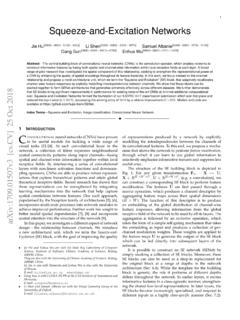Transcription of AVOIDING THE ECHO CHAMBER ABOUT ECHO CHAMBERS
1 AVOIDING THE. echo CHAMBER . ABOUT echo . CHAMBERS : Why selective exposure to like-minded political news is less prevalent than you think . ANDREW GUESS BRENDAN NYHAN. Department of Politics Department of Government Princeton University Dartmouth College | @knightfdn BENJAMIN LYONS JASON REIFLER. Department of Politics Department of Politics University of Exeter University of Exeter CONTENTS. AVOIDING THE echo CHAMBER ABOUT echo CHAMBERS | Contents 4 THE echo CHAMBERS CRITIQUE. 6 SELECTIVE EXPOSURE: A MORE COMPLEX STORY.
2 13 THE IMPORTANCE OF SOCIAL CONTEXT. 15 CONCLUSION. 17 REFERENCES. | @knightfdn 2 / 25. Is the expansion of media choice good for democracy? Not according to critics who decry echo CHAMBERS , filter bubbles, and information cocoons the highly polarized, ideologically homogeneous forms of news and media consumption that are facilitated by technology. However, these claims overstate the prevalence and severity of these patterns, which at most AVOIDING THE echo CHAMBER ABOUT echo CHAMBERS | Introduction capture the experience of a minority of the public.
3 In this review essay, we summarize the most important findings of the academic literature ABOUT where and how Americans get news and information. We focus particular attention on how much consumers engage in selective exposure to media content that is consistent with their political beliefs and the extent to which this pattern is exacerbated by technology. As we show, the data frequently contradict or at least complicate the echo CHAMBERS narrative, which has ironically been amplified and distorted in a kind of echo CHAMBER effect.
4 We instead emphasize three fundamental features of preferences for news ABOUT politics. First, there is diversity in the sources and media outlets to which people pay attention. In particular, only a subset of Americans are devoted to a particular outlet or set of outlets; others have more diverse information diets. Second, though some people have high levels of motivation to follow the latest political news, many only pay attention to politics at critical moments, or hardly at all. Finally, the context in which we encounter information matters.
5 Endorsements from friends on social media and algorithmic rankings can influence the information people consume, but these effects are more modest and contingent than many assume. Strikingly, our vulnerability to echo CHAMBERS may instead be greatest in offline social networks, where exposure to diverse views is often more rare. | @knightfdn 3 / 25. THE echo CHAMBERS . CRITIQUE. AVOIDING THE echo CHAMBER ABOUT echo CHAMBERS | The echo CHAMBERS critique News consumers now have innumerable options across media formats.
6 To deal with this glut of information, consumers have to make choices ABOUT what they consume. Worries that this process will lead to increasingly one- sided media diets center on three related concepts: selective exposure, echo CHAMBERS , and filter bubbles. Selective exposure refers to systematic bias in audience composition . (Sears and Freedman 1967) stemming from a tendency for individuals to select information that is congruent with prior attitudes (Klapper 1960) or that comes from like-minded sources (Iyengar and Hahn 2009).
7 Academic research refers to such preferences, whether for attitude-confirming information or for friendly sources, as congeniality bias (Hart et al., 2009). Selective exposure to congenial political information is sometimes analyzed as partisan selective exposure (Stroud 2008). In the current environment, the stereotypical news consumers engaging in selective exposure would be conservative Republicans who only watch Fox News or liberal Democrats who are dedicated to MSNBC. (The tendency toward selective exposure is real but also more complex than this caricature suggests, as we discuss below.)
8 Critiques of echo CHAMBERS or information cocoons go further, however, in suggesting not only that people overwhelmingly select into media and information flows that confirm their pre-existing biases but that these habits can reinforce people's views, exacerbating extremism. Sunstein, for instance, argues that the opportunity for personalization online the Daily Me (Negroponte 1995) has reduced exposure to competing views and accelerated the polarization of news consumers' political attitudes (2001.)
9 2009; 2017). This pessimistic view has grown only more prevalent as media options have proliferated. Concerns ABOUT ideological self-segregation have accompanied the expansion of cable television (Prior 2007; Jamieson and Cappella 2008), widespread adoption of broadband internet (Garrett 2009a;. Hindman 2008), and most recently the rise of social media (Bakshy, Messing, and Adamic 2015; Flaxman, Goel, and Rao 2016). Research on echo CHAMBERS examines whether these technological advances enhance the tendency to | @knightfdn selectively expose oneself to voices that please and comfort and whether they have further fragmented the electorate.
10 A variant of this argument focuses on online intermediaries such as Google and Facebook that seek to tailor individual users' experiences based on their personal characteristics, location, browsing histories, or social networks (Bozdag 2013). These personalization features generate search results and news feeds that differ in ways that are invisible to the user (Zuiderveen Borgesius et al. 2016). Although these features may be 4 / 25. aimed at increasing the relevance of information to which individuals are exposed, they may also create filter bubbles that reduce encounters with challenging information (Pariser 2011).







![arXiv:1701.07274v6 [cs.LG] 26 Nov 2018](/cache/preview/b/2/5/7/0/b/e/2/thumb-b2570be2ae0c346a241019b20f82e2dc.jpg)
